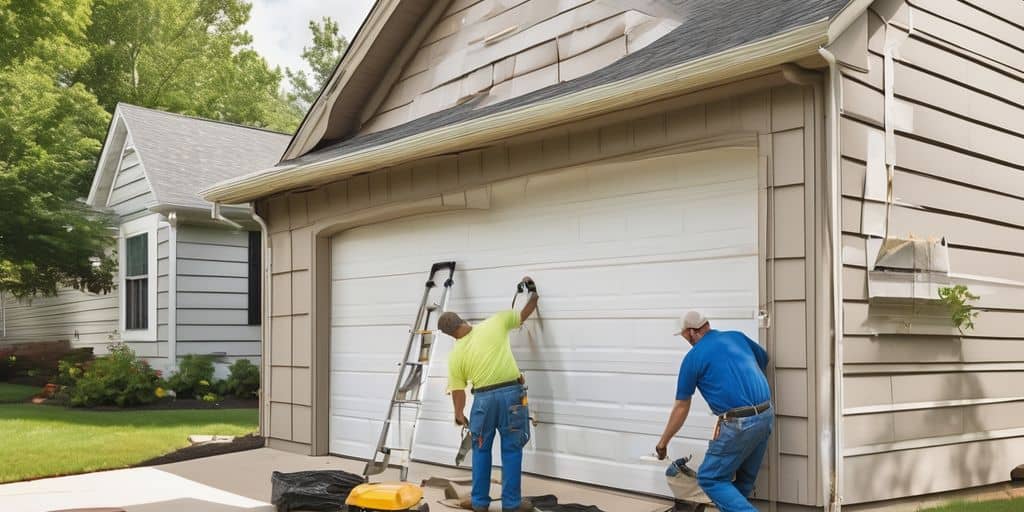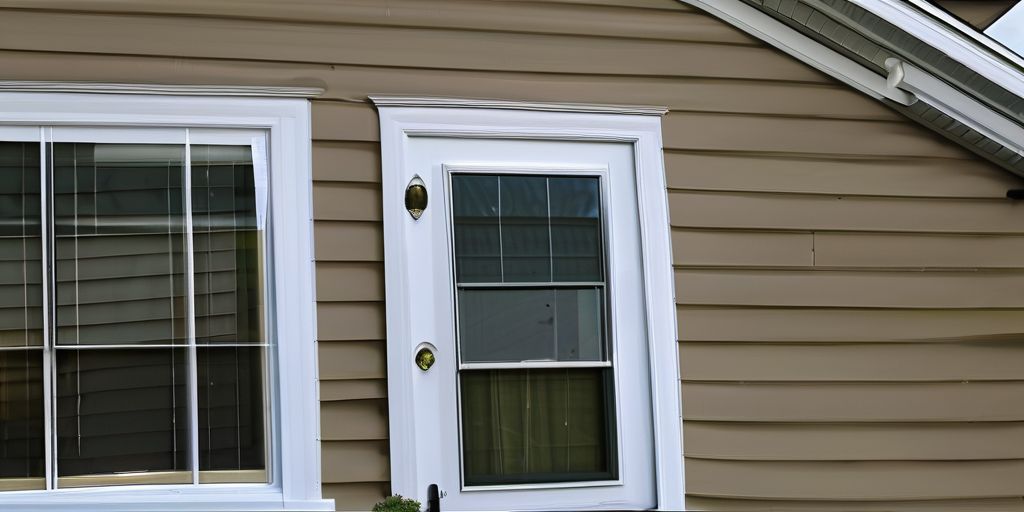Repairing scratches on vinyl siding before painting is crucial for a smooth and long-lasting finish. Unfixed scratches can lead to peeling paint and an uneven look. This article will guide you through the steps to fix those scratches and prepare your vinyl siding for a fresh coat of paint, ensuring your home looks its best.
Key Takeaways
- Fixing scratches on vinyl siding is important for a smooth and durable paint job.
- Using the right tools and repair compounds is essential for effective scratch repair.
- Cleaning the surface before applying repair compounds ensures better adhesion.
- Priming the repaired areas is crucial for a long-lasting paint finish.
- Sometimes, deep scratches may require professional help to fix properly.
Understanding the Importance of Repairing Scratches on Vinyl Siding
Why Scratches Need Attention
Taking the time to fix scratches and blemishes can significantly enhance the final appearance of your painted vinyl siding. By addressing these minor imperfections, you ensure a smooth and long-lasting finish. Routine maintenance is key to preserving the appearance and integrity of vinyl siding. Simple cleaning and inspections can prevent the need for extensive repairs.
Impact on Paint Adhesion
Repairing scratches on vinyl siding before painting is crucial to ensure a smooth and long-lasting finish. Unaddressed scratches can affect paint adhesion and lead to peeling or uneven coverage.
Long-Term Benefits
Repairing scratches not only improves the immediate appearance of your siding but also offers long-term benefits. A well-maintained vinyl siding not only enhances curb appeal but also protects your home for years to come. Regular maintenance, including cleaning and repairing scratches, is essential for long-lasting results. Use quality paint, primer, and tools to achieve a durable finish.
Essential Tools and Materials for Scratch Repair
To effectively repair scratches on vinyl siding, you’ll need a few essential tools:
- Fine-grit sandpaper
- Soft cloths
- Putty knife
- Utility knife
- Bucket and sponge
These tools will help you clean, sand, and apply repair compounds to the scratched areas.
Selecting the appropriate repair compound is crucial for a seamless fix. Small cuts and scratches can be permanently fused with a clear vinyl repair compound. Ensure the compound is compatible with vinyl siding and can withstand outdoor conditions.
Safety should always be a priority. Equip yourself with the following gear:
- Safety goggles
- Gloves
- Dust mask
These items will protect you from dust and debris while you work on the repairs.
Taking the time to gather the right tools and materials can make the repair process smoother and more efficient, ensuring a professional finish for your vinyl siding.
Step-by-Step Guide to Repairing Scratches on Vinyl Siding
Repairing scratches on vinyl siding is a crucial step before painting. Follow this guide to ensure a smooth and long-lasting finish.
Cleaning the Surface
- Start by cleaning the scratched area with soapy water and a sponge.
- Rinse thoroughly and let it dry completely.
- Ensure the surface is free of dirt and debris to allow the repair compound to adhere properly.
Applying the Repair Compound
- Apply a thin layer of vinyl siding repair compound to the scratch.
- Use a putty knife to smooth it out evenly.
- Allow the compound to dry completely before moving on to the next step.
Taking the time to fix scratches and blemishes can significantly enhance the final appearance of your painted vinyl siding.
Sanding and Smoothing the Area
- Once the repair compound is dry, use fine-grit sandpaper to sand the area.
- Sand until the surface is smooth and level with the surrounding siding.
- Wipe away any dust with a clean, damp cloth.
By following these simple steps, you can easily repair minor imperfections and prepare your siding for a fresh coat of paint, ensuring a beautiful and long-lasting result.
Preparing the Surface for Painting
Before painting your vinyl siding, it’s essential to prepare the surface properly to ensure a long-lasting and smooth finish. This involves several key steps that will help the paint adhere better and look more professional.
Common Mistakes to Avoid When Repairing Vinyl Siding
Skipping the Cleaning Step
One of the most common mistakes is skipping the cleaning step. Proper cleaning is essential to remove dirt, grime, and mildew that can affect the repair process. If you don’t clean the surface, the repair compound may not adhere properly, leading to further issues down the line. Always start with a clean surface to ensure the best results.
Using the Wrong Repair Compounds
Choosing the wrong repair compounds can lead to poor results. It’s important to select a compound that is specifically designed for vinyl siding. Using the wrong type can result in a repair that doesn’t last or looks unprofessional. Make sure to read the labels and choose the right product for your needs.
Ignoring Safety Precautions
Safety should always be a priority. Ignoring safety precautions can lead to accidents and injuries. Always wear the recommended safety gear, such as gloves and safety glasses, to protect yourself during the repair process. Additionally, make sure to follow all safety guidelines provided with your tools and materials.
Remember, taking the time to prepare the surface meticulously will pay off in the longevity and quality of your paint job.
By avoiding these common mistakes, you can ensure a smoother and more effective repair process for your vinyl siding. Whether you’re working on a small scratch or a larger area, attention to detail and proper preparation are key to achieving the best results.
When to Seek Professional Help for Vinyl Siding Repairs
Determining whether to tackle a vinyl siding repair yourself or call a professional often depends on the extent of the damage. Minor scratches and scuffs can usually be handled with some basic tools and materials. However, if you notice deep gouges, extensive cracking, or warping, it might be time to seek expert help. Professionals have the experience and equipment to handle more severe issues effectively.
Regular inspections can help you catch new damage early, preventing more extensive repairs down the line. Look for:
- Cracks or splits in the siding.
- Discoloration or fading.
- Loose or missing pieces.
- Mold or mildew growth.
Identifying Deep Scratches
Deep scratches are more than just surface blemishes. They can expose the underlying material, making your siding vulnerable to moisture and further damage. Addressing these issues promptly can save you from more costly repairs in the future.
Evaluating the Extent of Damage
Before deciding on a repair approach, evaluate the extent of the damage. If the damage is widespread or affects multiple panels, professional intervention may be necessary. Experts can provide a thorough assessment and recommend the best course of action.
Benefits of Professional Repair Services
Hiring a professional for vinyl siding repairs offers several advantages:
- Expertise: Professionals have the knowledge to handle complex repairs.
- Quality Workmanship: Ensures a longer-lasting repair.
- Proper Tools: Access to specialized equipment for effective repairs.
- Time-Saving: Quick and efficient service, minimizing disruption to your daily routine.
Regular maintenance and timely repairs can keep your vinyl siding looking great and protect your home for years to come. If you’re unsure about the severity of the damage, it’s always best to consult with a professional.
If your vinyl siding is showing signs of wear and tear, it might be time to call in the experts. Professional help ensures that the job is done right, saving you time and potential headaches. Don’t wait until the damage gets worse. Visit our website to learn more about our services and get a free estimate today!
Conclusion
Repairing scratches on vinyl siding before painting is a key step to achieving a smooth and long-lasting finish. By taking the time to fix these imperfections, you ensure that the paint adheres properly and looks even. Using the right tools and following a step-by-step process can make the job easier and more effective. Whether you’re a DIY enthusiast or considering professional help, addressing scratches before painting will save you time and effort in the long run. With proper preparation, your vinyl siding can look fresh and beautiful for years to come.
Frequently Asked Questions
Why is it important to repair scratches on vinyl siding before painting?
Fixing scratches on vinyl siding before painting is key to getting a smooth and long-lasting finish. If you don’t fix them, the paint might not stick well and could peel or look uneven.
What tools do I need to repair scratches on vinyl siding?
You’ll need some basic tools like fine-grit sandpaper, a vinyl siding repair kit, a putty knife, and cleaning stuff like soapy water and a sponge. Don’t forget safety gear like gloves and goggles.
How do I apply the repair compound?
Put a thin layer of vinyl siding repair compound on the scratch. Let it dry completely before you start painting. This helps make sure the paint goes on smoothly.
Can I repair deep scratches on vinyl siding myself?
You can fix small scratches with a repair kit, but deep scratches might need a professional to make sure the repair is smooth and doesn’t cause more damage.
What should I do to prepare the surface for painting?
First, clean the area well and let it dry. Then, apply a primer to the repaired spots. Choose the right paint and make sure it sticks well to the surface.
When should I call a professional for vinyl siding repairs?
If you find deep scratches or a lot of damage, it’s best to call a professional. They have the tools and skills to fix it right and make it look good.




